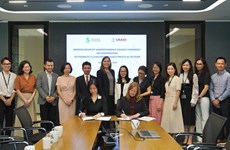Vietnam leads in renewable energy
Vietnam has seen the greatest rise in the proportion of electricity
generated through renew-ables in ASEAN, according to a report released
by a British accounting body on June 3.
Vietnam has seen the greatest rise in the proportion of electricity
generated through renew-ables in ASEAN, according to a report released
by a British accounting body on June 3.
The Institute of Chartered Accountants in England and Wales's latest Economic Insight said ASEAN's renewable generation capacity had grown by 83 percent between 2002 and 2012, led by Vietnam which had added 34 billion kWh of hydropower.
However, the nation still faced green challenges as it continued its transition from an agrarian to a manufacturing economy. Large inflows of foreign investment would increase the industry's output in the medium term.
Last year had marked a positive turning point in climate change where carbon dioxide emissions remained constant for the first time while world output grew.
Environmental degradation generally accompanied economic development up to a point, after which further development relieved environmental pressure.
Figures showed that globally, the point may have been reached where advanced economies had moved to sustained clean growth.
The situation was less bright in ASEAN, where most economies had not reached a stage where the environmental impact of economic activity started to decrease. With the exception of Singapore, which had seen a sustained drop in emissions since 1994, other countries like Indonesia, Malaysia, and the Philippines were only seeing periodic lower emissions when GDP shrank.
An encouraging sign for Vietnam was its high proportion of electricity generated through renewables instead of fossil fuels, with hydropower accounting for almost half of its entire electricity generation.
Vietnam was leading in this area, while its ASEAN counterparts still lagged behind in renewable generation capacity.
Over the last decade, environmental policy across ASEAN had been higher on the agenda, but progress remained difficult. While environmental policy in Singapore had been relatively successful, plans in other ASEAN nations such as the Philippines and Thailand had been more modest.
As the global economy moved towards cleaner growth, ASEAN needed to keep pace. Across the region, lower environmental impact from its development would make it a more desirable place for individuals and firms to move to.
Scott Corfe, ICAEW economic advisor and Cebr associate director, said, "Manufacturing activities have a strong effect on emissions, since they produce more than three times the carbon emissions - per 1,000 USD of output - than service activities. While ASEAN has seen a positive move towards cleaner manufactures, this is undermined by a growing dependence on commodities as China's expansion has kept demand strong.
"It will be helpful for Vietnam to diversify its exports away from commodities and consider cleaner manufactures. This will reduce its reliance on China as an export market for coal in case the Asian giant's economy slows and also help reduce Vietnam's environmental footprint."
Mark Billington, regional director, ICAEW South East Asia, said: "Much more is needed to translate environmental policies into reality, including a stronger regulatory environment, political will and funding. Commodity-rich ASEAN nations like Indonesia and Vietnam may be attracted by the short-term gains in GDP that can be reaped at the expense of natural capital stocks – for example, the natural wealth locked in resources such as forests.
"One way to ensure more sustainable growth is to consider natural capital accounting. By calculating the value of critical assets, their proper use can be measured and managed to ensure long-term sustainability for both organisations and for the environment."
Economic Insight: South East Asia, produced quarterly for ICAEW by Cebr, its partner and economic forecaster, provides its 144,000 members with a current snapshot of the region's economic performance.
It undertakes a review of Southeast Asian economies, with a focus on Indonesia, Malaysia, the Philippines, Singapore, Thailand, and Vietnam.-VNA
The Institute of Chartered Accountants in England and Wales's latest Economic Insight said ASEAN's renewable generation capacity had grown by 83 percent between 2002 and 2012, led by Vietnam which had added 34 billion kWh of hydropower.
However, the nation still faced green challenges as it continued its transition from an agrarian to a manufacturing economy. Large inflows of foreign investment would increase the industry's output in the medium term.
Last year had marked a positive turning point in climate change where carbon dioxide emissions remained constant for the first time while world output grew.
Environmental degradation generally accompanied economic development up to a point, after which further development relieved environmental pressure.
Figures showed that globally, the point may have been reached where advanced economies had moved to sustained clean growth.
The situation was less bright in ASEAN, where most economies had not reached a stage where the environmental impact of economic activity started to decrease. With the exception of Singapore, which had seen a sustained drop in emissions since 1994, other countries like Indonesia, Malaysia, and the Philippines were only seeing periodic lower emissions when GDP shrank.
An encouraging sign for Vietnam was its high proportion of electricity generated through renewables instead of fossil fuels, with hydropower accounting for almost half of its entire electricity generation.
Vietnam was leading in this area, while its ASEAN counterparts still lagged behind in renewable generation capacity.
Over the last decade, environmental policy across ASEAN had been higher on the agenda, but progress remained difficult. While environmental policy in Singapore had been relatively successful, plans in other ASEAN nations such as the Philippines and Thailand had been more modest.
As the global economy moved towards cleaner growth, ASEAN needed to keep pace. Across the region, lower environmental impact from its development would make it a more desirable place for individuals and firms to move to.
Scott Corfe, ICAEW economic advisor and Cebr associate director, said, "Manufacturing activities have a strong effect on emissions, since they produce more than three times the carbon emissions - per 1,000 USD of output - than service activities. While ASEAN has seen a positive move towards cleaner manufactures, this is undermined by a growing dependence on commodities as China's expansion has kept demand strong.
"It will be helpful for Vietnam to diversify its exports away from commodities and consider cleaner manufactures. This will reduce its reliance on China as an export market for coal in case the Asian giant's economy slows and also help reduce Vietnam's environmental footprint."
Mark Billington, regional director, ICAEW South East Asia, said: "Much more is needed to translate environmental policies into reality, including a stronger regulatory environment, political will and funding. Commodity-rich ASEAN nations like Indonesia and Vietnam may be attracted by the short-term gains in GDP that can be reaped at the expense of natural capital stocks – for example, the natural wealth locked in resources such as forests.
"One way to ensure more sustainable growth is to consider natural capital accounting. By calculating the value of critical assets, their proper use can be measured and managed to ensure long-term sustainability for both organisations and for the environment."
Economic Insight: South East Asia, produced quarterly for ICAEW by Cebr, its partner and economic forecaster, provides its 144,000 members with a current snapshot of the region's economic performance.
It undertakes a review of Southeast Asian economies, with a focus on Indonesia, Malaysia, the Philippines, Singapore, Thailand, and Vietnam.-VNA













